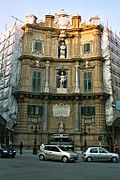Quattro Canti (Palermo)
Quattro Canti (German: four corners ), more precisely Quattro Canti di città , is a square in the historic center of Palermo , the capital of Sicily, framed by the Baroque architecture of the Quattro Canti . It is located at the intersection of the two traffic axes Corso Vittorio Emanuele and Via Maqueda and is one of the outstanding works of baroque architecture in Palermo. It is officially called Piazza Vigliena after the Spanish viceroy Juan Fernandez Pacheco de Villena , who had the architectural ensemble built. The square is also called Teatro del Sole because the sunlight falls on one of the corner facades throughout the day.
history
The square was created during a city expansion to the east in the 17th century. The Cassaro (today Corso Vittorio Emanuele ), which has served as the main street of Palermo since the time of Arab rule in the 9th century , and which starts from the Norman Palace, was extended to the east (more precisely: east-northeast ) to the sea and widened overall. In 1608, the Spanish viceroy Maqueda had another large street built at right angles to it, Via Nuova (now Via Maqueda). The two streets divide the old town into the districts Albergheria, Seralcadio (unofficially also called Capo), La Loggia and Kalsa, which roughly correspond to today's mandamenti Palazzo Reale, Monte di Pietà, Castellammare and Tribunali.
The intersection of the two streets was expanded into an octagonal square with curved facades, called Piazza Vigliena. The expansion of the square lasted from 1608 to 1620. The architect Giulio Lasso , who came from Florence, built a palace at each of the four corners of the intersection.
description
| Compass direction | South-southwest | West-northwest | North-Northeast | East-Southeast |
| image |

|

|

|

|
| District | Albergheria | Seralcadio / Capo | La Loggia (Palermo) | Kalsa |
| Mandamento | Palazzo Reale | Monte di Pietà | Castellammare | Tribunali |
| season | spring | summer | autumn | winter |
| Ruler | Charles V | Philip II | Philip IV | Philip III |
| Patron saint | Cristina | Ninfa | Oliva | Agatha |
The facades of the four palaces are concave, divided into three parts and decorated with statues and ancient columns. In the base niches there are fountains, whose fountains and statues symbolize the four seasons. In the middle area are the statues of the Spanish kings Charles V , Philip II , and Philip III in central niches . and Philip IV. The statues in the upper area represent the four patron saints of the districts at that time: Agatha , Cristina, Ninfa and Oliva .
The fountains and sculptures are framed by columns that follow the order Doric , Ionic and Corinthian from bottom to top .
Behind the palace facade on the south-southwest corner is the Basilica of San Giuseppe dei Teatini .
literature
- Brigit Carnabuci: Sicily. Greek temples, Roman villas, Norman cathedrals and baroque cities in the center of the Mediterranean (= DuMont art travel guide ). 6th, updated edition. DuMont Reiseverlag, Ostfildern 2011, ISBN 978-3-7701-4385-6 .
- Cesare De Seta, Maria Antonietta Spadaro, Sergio Troisi: Palermo città d'arte. Guida ai monumenti di Palermo e Monreale. Ariete, Palermo 1998, pp. 313-315.
Individual evidence
- ↑ to distinguish it from the Quattro canti di campagna , which emerged towards the end of the 18th century and today form the intersection of Via Ruggero Settimo and Via Mariano Stabile, see: Adriana Chirco, Mario Di Liberto: Via Ruggero Settimo ieri e oggi. D. Flaccovio, Palermo 2002, ISBN 88-7758-469-6 , pp. 12-13.
Web links
Coordinates: 38 ° 6 ′ 57 ″ N , 13 ° 21 ′ 41 ″ E




